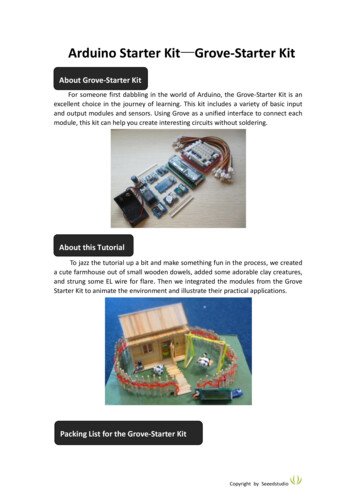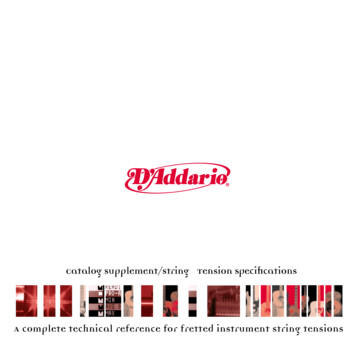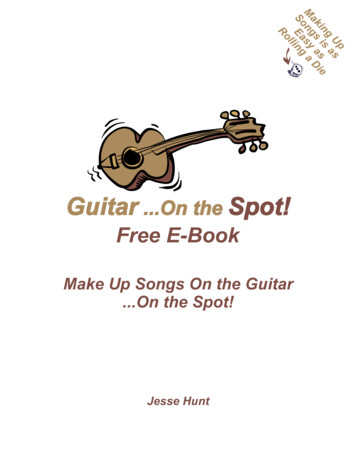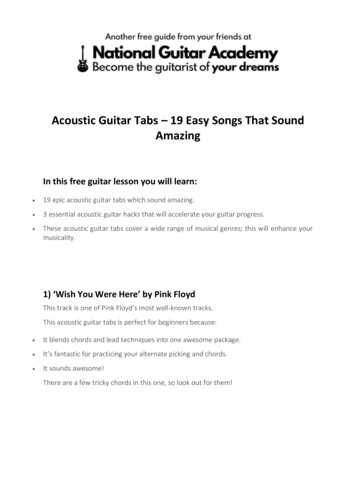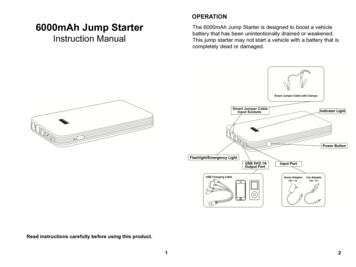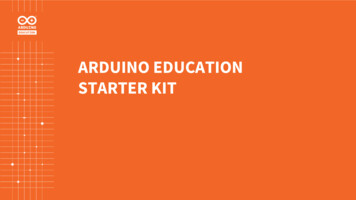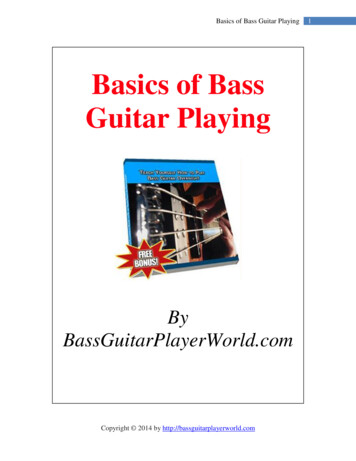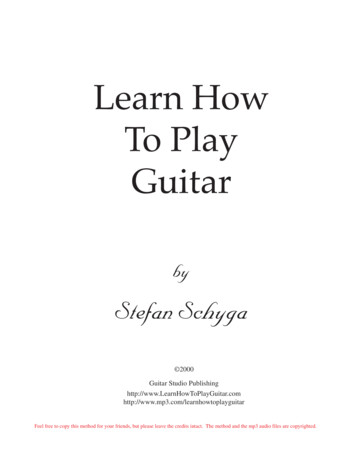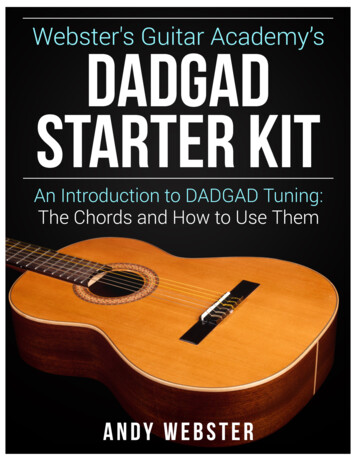
Transcription
INTRODUCTIONI began playing DADGAD guitar almost by accident. In 2001, I auditioned to join a particularScottish folk group. I showed what I could do in standard tuning on one guitar (which I was mostcomfortable with) and demonstrated the one song I knew in DADGAD on my other guitar. Theaudition went well and I got to join the band, but the piper told me not to bother bringing mystandard tuned guitar again. Such is the effect of DADGAD, and other open tunings, in Celticmusic. To put it simply, they sound great.If you are reading this right now, then it is very likely that you have an interest in learning how toplay guitar in DADGAD tuning. There’s a good chance that you also have an interest in Celticmusic and may even have experienced it live, either as a listener or by taking part in a sessionor band setting.The aim of this starter kit is to advance the knowledge of anyone who may be thinking of tryingDADGAD or is dabbling with it at present. Some of it may even be of use to guitarists that do notknow where to go next with the tuning - particularly anyone who desires to better understand thetonalities involved in Celtic music and how DADGAD tuning can be applied to them.To make best use of these pages, one should apply their content to all manner of Celtic tunesand songs too, if desired. For beginners, it will be best if this content is applied to versions oftunes that have chords provided already – many of these can be found on the Webster’s GuitarAcademy site. I recommend getting used to the chord shapes first and then trying to experimentwith the substitution pages after. More advanced players may find the pages on modes useful inhelping to identify what mode a tune is in so that they can then work out what set of chords andsubstitutions can be used in accompaniment.Whatever level you are at as you use this book, I hope it lifts your level of playing andunderstanding, thus gifting Celtic music and the world with a good few more talented DADGADguitarists.Andy Websterwww.webstersguitaracademy.comWebster’s Guitar Academy’s DADGAD Starter KitPublished March 2016.Copyright Andy Webster 2016 All Rights ReservedCover by bookdesign.
TUNING TO DADGADTune to: DADGADAs with any tuning, the easiest way to tunenowadays is to use an electronic tuner.Using this method, tune your strings to thenotes shown:String: 6 5 4 3 2 1Standard tuning: E A D G B EIf tuning by ear from standard tuning, then thefollowing method can be used:EEDADGADFrom standard tuning, tune the 6th string (E) to the4th string (D) until they sound the same, but anoctave apart.Next, tune the 1st string (E) to the 4th string (D) untilthey also sound the same and an octave apart.String:6 5 4 3 2 1BDADGADFinally, tune the 2nd string (B) to the 5th string (A)until they sound the same, but an octave apart.String:6 5 4 3 2 1
DADGAD CHORDSIn some cases, to make things simpler, the chord name given in these charts isnot the proper name. The reason for this is that, often times the 1st and 2ndstrings in DADGAD are left open to ring out as a kind of drone or inverted pedal.EXAMPLEEm7Em7 at the second fret should actually be called Em7sus4, butmost times inEm7at the whatsecondmostfret peopleshould wantactuallybe calledDADGDADto hearis an Em7 chordwith2 3 4 0 0the0 high AEm7sus4,but oftentimeswhatmost charts. theand D stringsringingout inonDADGDADtop. Hence,in theseEm7 aspect of thepeopleto hearfocusedis their desiredchordnamingwith the it.high Achord wanthas beenon whenand D strings ringing out on top.There should be no A note in an Em7 chord; the A iswhat makes this chord an Em7sus4.Thus, the Em7 aspect of the chord has been focused onwhen naming it.E BEGADIn the following charts then, some chords will be named as in the manner shownabove. Where possible though, if the proper name of a chord should not happento be too long, then it will be given, such as this Asus4 at the 6th fret.A(sus4)2 3 x 1 0 06fr
6fr4fr4frx 4 2 1 (0)(0)x 4 2 1 (0)(0)0 0 1 4 0 04fr7frx 4 3 1 (0)(0)G7frx 1 3 4 0 0Bm77fr2 x 0 1 3 (0)Bm73 4 0 1 0 02 3 0 1 0 0Bm7x 4 1 2 0 0A/C#9fr2 0 0 1 4(0)Asus4/C#3 0 4 1 0 09fr2 0 3 1 0 0A/C#11fr0 0 3 1 0 0D2 0 0 1 0 0D11fr3 0 0 2 0 02 0 0 1 0 0DThese 4 chords go well with the versions of chords D5 to G on the first line.x 0 2 3 0 4A56fr4fr6fr2 x 0 0 3 (0)Asus43 4 x 2 0 02 3 x 1 0 0A(sus4)2 x 0 1 3 (0)G(Alternative fingering)3 4 02 0 02 3 01 0 0GThese 4 chords go well with some of the higher position versions of A and Bm7F#mEm7D2 3 4 1 0 01 2 0 0 3 0F#m3 0 0 1 0 0D/F#DADGAD CHORDS – D Major0 0 0 1 0 0Em72 3 4 0 0 00 4 0 1 0 0D5Em7D5The 8 shapes on the first line below will give you a solid foundation forplaying in D major. Most tunes in D major, E dorian, A mixolydian andB Aeolian (natural minor) can be accompanied using only these. Thefollowing lines offer either alternative versions or substitutions.
2 x 1 1 3 x2 x 0 1 3 01 2 0 0 3 01 2 0 0 3 x5frD/A (sus4)Em7/G7fr(Alternative fingering)3 x 1 1 4 xAm7G4frx 0 1 0 3 (0)2 x 0 0 3 (0)5frAm7G5G/B1 2 0 0 3 0G/B9fr10fr1 2 0 0 3 (0)C(add9)9fr2 x 0 1 3 (0)C(sus2)x 2 10 3 0C(add9)7fr0 2 1 1 3 (1)D11fr5fr9frx 2 0 0 3 (0)Em7x 2 1 3 4 xEm7D2 x 0 0 3 (0)2 3 4 0 0 0Em70 4 0 1 0 0D5DADGAD CHORDS – G Major7fr3 x 1 1 4 x2 x 1 1 3 xBm7x 2 0 0 3 0The 8 shapes on the first line below will give you a solid foundation forplaying in G major. Most tunes in G major, A dorian, D mixolydian andE Aeolian (natural minor) can be accompanied using only these. Thefollowing lines offer either alternative versions or substitutions.7fr11frΩΩΩ0 2 0 1 3 0D0 2 0 1 30D(/F#)3 0 0 1 0 0D/F#(0) 2 1 0 3 0G12fr9fr(0) 2 1 0 3 0G2 x 0 0 3 (0)G
Bm72 3 0 1 0 0A5T 0 1 4 0 2* There are not many tunes written in these modes.3 4 0 1 0 0x 1 3 4 0 0x 0 2 3 0 47frBm7A57frA/C#9frGood substitute for A/C#3 4 x 1 (0)(0)9fr2 3 x 1 (0)(0)x 0 1 2 0 0E7sus4/A6fr4frx 0 1 3 0 0F#m/Ax 4 2 1 2 xF#mEx 4 3 1 x x2 3 4 1 0 0F#m2 3 x 1 4 (0)E(7)These 5 chords go well together.4frx 0 1 4 0 0D/A11fr2 0 01 0 0D0 4 01 0 0D5DADGAD CHORDS – A MajorGood substitute for A/C#C#m3 0 4 1 0 0A/C#x 4 1 2 0 0The 8 shapes on the first line below will give you a solid foundation forplaying in A major. Most tunes in A major, B dorian, E mixolydian*and F# aeolian* (natural minor) can be accompanied using onlythese. The following lines offer either alternative versions orsubstitutions.4fr6fr3 4 x 1 x xx 0 1 4 0 0E7sus4/A6fr6frx 2 1 3 4(0)E7(Alternative fingering)4fr2 3 x 1 x xE/G#T 0 1 4 0 2A56frx 0 2 1 3 (0)A3 4 x 1 0 (0)6fr2 3 x 1 0 (0)A(sus4)T Thumb
2 3 4 1 x x2 x 3 1 4 x2 3 4 1 x xAm5fr1 2 0 0 3 00 4 2 1 0 02 x 3 1 4 xFF2 3 x 1 0 4D50 4 0 1 0 0Below are alternative shapes for playing in D minor. Those marked with * indicate thatthese chords are actually from the scale, D harmonic minor.C/EDmThe 8 shapes below will give you a solid foundation for playing in D (natural) minor.Note that the same chords are used in F major. This is because both keys are relativeto each other, i.e., the scales of both keys share the same notes and thus, the samechords.GmFThese 8 shapes will give you a solid foundation for playing in F major.5fr2 x 0 0 3 xG53 x 11 x xGm7(Alternative fingering)3 4 x1 x x2 3 x1 x xGood substitute for AmF/A7fr6fr2 3 x 1 0 0*A(sus4)5fr3 x 1 1 x xAm72 3 4 1 x 0Bb9fr7fr2 3 x 1 x 0Bb2 3 4 1 x xCDADGAD CHORDS – F Major & D (Natural) Minor3 0 4 1 0 02 0 3 1 0 (0)*A/C#9fr2 x 0 1 3(0)C(sus2)3 0 0 1 0 010fr2 0 0 1 0 0Dm2 0 0 1 3 0Dm1 2 x 0 3 xC/E10fr(2fr)
7fr3 4 x1 x x2 3 x 1 x xCm8fr2 0 0 1 0 0Dm2 3 x 1 4 x2 x 0 1 3 05fr2 2 0 1 4 0Bb7fr10fr3 4 x1 x x7fr2 3 0 1 0 02 3 x 1 x x3frBbmaj7Eb/GBb/D10fr2 3 x1 4 xCm8fr3 4 x1 x x2 3 x1 x xGood substitute for DmBelow are alternative shapes for playing in Bb and G minor. Those marked with * are bestused with G minor and indicate that they are actually from the scale, G harmonic minor.F/AGmThe 8 shapes below work well for playing in G (natural) minor.Shapes from the line above can substitute those of the same name below .2 3 x 1 x xBbThese 8 shapes will give you a solid foundation for playing in Bb major.0 4 2 1 0 0Dm10fr2 0 0 1 3 0Dm1 1 1 4 1 1Eb1 1 1 4 1 1Eb52 3 x 1 x xFDADGAD CHORDS – Bb Major and G (natural) minor3 0 0 1 0 0*D/F#1 1 1 4 11F53 4 x 1 x x2 3 x 1 x xGm2 x 0 0 3 0G52 3 x 1 x xF/A5fr
MODESEven if your ear is already very good, it can help immensely to know what key, ormode, you are playing in. The following pages are by no means an exhaustivestudy of this subject, but they will hopefully help you start to understand howmodes are present in Celtic music and how your ability to accompany can beimproved by doing so.If you have ever sat in a Celtic session, you will no doubt have heard someonesay that a tune is in Em when it may not actually be. Similarly, you might haveheard a tune described as being in the key of A, but being "a bit modal". You maynot even have been aware that they were wrong in saying this, but you may havenoticed that it was tricky to work out the chords or that some of the chords younormally use for those keys didn’t quite fit.Most Irish and Scottish music is written using the major scales of D, G and A aswell as some of the modes that can be derived from each of these scales.WHAT IS A MODE?Em7 at the second fret should actually be called Em7sus4, but most times inAmode is a scale,a group ofnotestothatcanisbeanusedto s peoplewanthearEm7chordwith theAwithalso fromwhich chordsbeHence,created. inFortheselearningpurposes,notesof a scaleorand andD stringsringingout oncantop.charts.the theEm7aspectof themodeorderedhighest aschordarehasbeenstepwisefocusedfromon lowestwhentonamingit. demonstrated below in the D major scale,also known as the Ionian mode.A tune many people know is “The Silver Spear” which is written using the Dmajor scale; i.e., the melody was created using the notes of this scale. Thechords used to accompany it can then be created from the scale also. Theprocess of basic chord creation is demonstrated on the following pages and thechord shapes themselves can be found on the chord charts in this booklet.
The first part of the well known reel “Drowsy Maggie” is written using the modeabove: E dorian. This means that this part of the tune is written using the notes ofthe D major scale, but they have been reordered so that the note E is now moredominant than the D. The Em also becomes the most dominant chord giving thetune a minor feel, but parts of it may sound more major than “true” E minor.As D major and E dorian share the same notes, then they will also share thesame chords, which means that one set of chords will suffice for playing in Dmajor as well as any of the modes that derive from it (such as A mixolydian or BAeolian). This rule is the same for all other keys, so once you learn the chords forG major and A major, you will have learned enough chords to be able to play inall of the most commonly used modes used in Celtic music. All with only threesets of chords!The next three pages will hopefully demonstrate these modes to you clearly andhelp you to begin to understand them. Your next step is to start identifying whatmode the tune you are accompanying is in so that you can use the right set ofchords.
Common Modes of Scottish/Irish Music D major based modes D Major (Ionian Mode)D DAGDADN.B. All these modesshare the same keysignature which iswhy they are related. 4 70E2F# G45AB02C# D04E2F# G40A0B2C# DEF# G02445etc.420420Tune Example: Tripping Up The Stairs etc. E Dorian (often mistakenly called Em)245024024002402457542042Tune Example: Morrison's Jig A Mixolydian Modeetc. 024024002402457911121197542Tune Example: The Devil In The Kitchen 10B Aeolian (B natural minor)etc. 2402400240245791112141211975Tune Example: Maggie's Pancakes4
D Major Chord Substitutions D EF# G A BC#D D example of diatonic harmony: i.e., how to make up chordsChords derived from scale in order. DEm F#mG A Bm C#º(dim)A EmF#mDA(7)Dmaj7Bm Dmaj7Gmaj7 A/C# Substitutions arealigned as so: Most common substitutionsBm G Additional substitutions Gmaj7 F#mCmaj7 Em7
Common Modes of Scottish/Irish MusicG major based modes G Major (Ionian Mode) G DAGDAD 5A0B2C3D0E2F# G40ABC023DEF# GABC02479105etc.975420Tune Example: The Blackthorn Stick etc.A Dorian (often mistakenly called Am)023024002302457910121097542Tune Example: The Lilting Banshee etc.D Mixolydian Mode024502302400203245420320Tune Example: The Hag at the Churn E Aeolian (E natural minor) etc. 24502302400230245754203Tune Example: The Rights of Man2
G Major Chord Substitutions G ABCDEF# G example of diatonic harmony: i.e., how to make up chords Chords derived from scale in order.G G AmBm AmBm CD C DDAm EmGmaj7Most common substitutionsEm C EmF#º(dim)Em F#º(dim)Bm G D(7) Cmaj7D/F# G G Additional substitutions Cmaj7 Bm Fmaj7 Gmaj7 Am7
Common Modes of Scottish/Irish MusicA major based modes A Major (Ionian Mode) A DAGDAD0B2C# D40E2F# G# ABC# DEF# G# ABC# D024024911416712etc.1197642Tune Example: Stan Chapman'sB Dorian (often mistakenly called Bm) 4etc. 24024102402467911121412119764Tune Example: McFadden's Reel7E Mixolydian Mode etc. 246024024102402467642042Tune Example: There are few of these, if any. Both McArthur Road and Calliope House could be accompanied by the chords of this modethough, as neither have D# notes in their melodies, thus allowing the use of chords using the D natural note present in E mixolydian.10 F# Aeolian (F# natural minor) etc. 460240241024024679764204Tune Example: Haud Awa' Hame.There are very few examples of tunes in this mode also.
A Major Chord Substitutions A BC#DEF# G#AG#º(dim)A example of diatonic harmony: i.e., how to make up chords Chords derived from scale in order.ABmC#mD A BmC#m D E E Bm F#mAmaj7Most common substitutions F#mD EF#m F#mG#º(dim)C#m A E(7) Dmaj7E/G# A Additional substitutions Dmaj7 C#m Gmaj7Amaj7 Bm7
these chords are actually from the scale, D harmonic minor. 6fr The 8 shapes below will give you a solid playing in D (natural) minor. Note that the same chords used in F major. This is because keys are relative to each other, i.e., the scales of both
